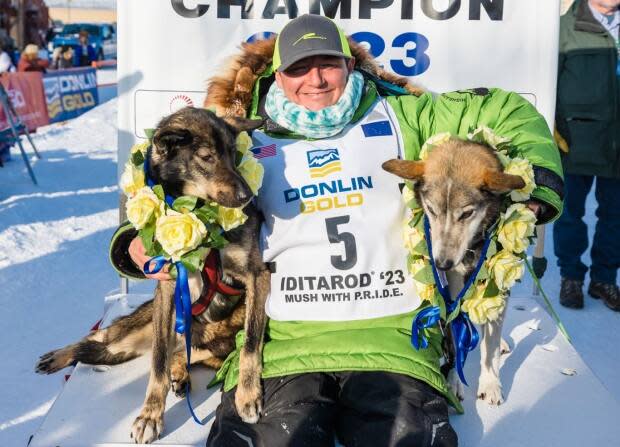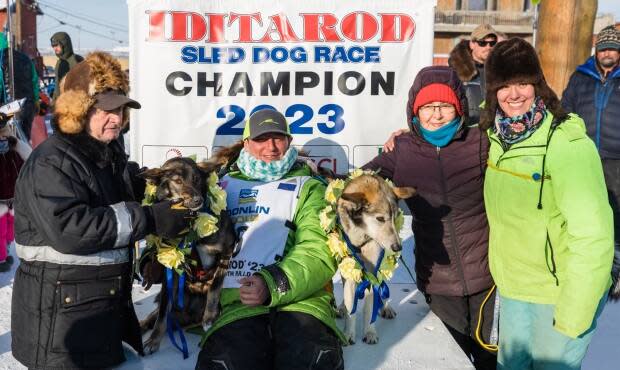Iñupiat musher takes 1st place at Alaska's Iditarod dog sled race

When Ryan Redington was just five years old, he found an old towline and tried to hook his puppies up to a tricycle.
This year, he was the first to cross the finish line at the Iditarod, a 1,500 kilometre dog sled race across Alaska, from Anchorage to Nome.
Redington, who is Iñupiat, is from Knik-Fairview, Alaska. He is the sixth Indigenous dog sled racer to win the Iditarod, completing the race in eight days and 21 hours.
"My family has taught me how to mush," he said.
His grandfather Joe Redington was the founder of the Iditarod, and his grandfather, father and uncle are in the Mushers Hall of Fame.
This year, the top three spots went to Indigenous racers with Pete Kaiser, who is Yup'ik, finishing second, and third place going to Richie Diehl, who is Dena'ina Athabaskan.
"It took me 16 years to win the race," said Redington.
He said there are many factors that can hinder a victory such as sleep deprivation, oversleeping at a checkpoint or getting lost. This year his sled broke, and he fell asleep and got lost during the race.
"The dogs decided to go off the trail," said Redington.
"When I woke up, there was no trail markers in sight and I decided the dogs must know about where we were going so I kept mushing with them."
The dogs are trained to identify the trail markers, placed about every three-quarter miles (1.2 km) along the trail.

Sarah Keefer, who has been Ryan's mushing partner since 2017, knows the dogs well.
"Sven and Ghost, they're both really driven lead dogs," she said.
"Their key interest is in seeing what's farther down the trail. They don't care about playing with the dogs behind them or what's happening anywhere besides going forward."
She said this determination is what defines a lead dog.
"[Sven] was always one of the dogs that if we start to take a short rest to fix something on the sled or something, Sven was always one of the first to start barking, 'Let's keep going. We don't want to stop.'
"So Ryan put him up in lead."
'An extreme sport'
Dr. Veronica C. Devall, a dog sled race vet for more than 25 years and an Iditarod race veterinarian for 13 years, said the dogs go through a pre-screening process which includes bloodwork and an electrocardiogram to check their heart and ensure their health is optimal for this sport.
Sled dogs run nearly 13 km/h, on average, throughout the race.
"These dogs are incredible," she said.
"They are the best of the best. It is an extreme sport when you're talking about the endurance race of the Iditarod."
When teams arrive at checkpoints, veterinarians examine each dog from "nose to tail." The prognosis of each dog is logged daily.
"At least one of the veterinarians likes to be watching them come in, that way we can watch how they're moving, if there's any dogs that look like they're limping or not running well," she said.
The dogs are given straw to sleep on, fresh water and a meal and their booties are taken off.
"Your team is only as strong as the weakest link. Basically, if your dog is not going then that slows you down," she said.
Growing up dog sledding
Redington's mom, Barbara Redington was one of the first to greet her son at the finish line.
She is Iñupiat and was born in Unalakleet, in western Alaska. Her grandfather delivered mail by dog sled, checking his trap lines along the way.

She said she remembered him coming home from school as a fourth grader one windy day in March, getting off the bus and immediately wanting to go mushing.
"He walked in, and he told his dad 'Can we go hook up a team?'" she said.
His father, Raymie Redington, who raced in the Iditarod 14 times, suggested they wait until the wind died down. But when Ryan told him that Martin Busher had just won the Iditarod in a blizzard, his dad acquiesced.
She said Ryan's win is "pretty special," considering that the trophy is a small bronze statue of his grandfather.

 Yahoo Sports
Yahoo Sports 